Extraction, Purification and Primary Characterization of Polysaccharides from Defatted Peanut (Arachis hypogaea) Cakes
Abstract
:1. Introduction
2. Results and Discussion
2.1. The Composition of Defatted Peanut Cake and Its Carbohydrate Content
2.2. Model Fitting and Response Surfaces Analysis
2.2.1. Statistical Analysis and the Model Fitting
2.2.2. Analysis of Response Surfaces
2.2.3. Optimization of Extracting Parameters and Validation of the Model
2.3. Separation and Purification of the PPC
2.4. Characterization of Polysaccharides
2.4.1. Identification of Polysaccharide Components
2.4.2. Molecular Weight Determination
2.4.3. Analysis of Monosaccharide Composition
2.4.4. FT-IR Spectroscopy
3. Materials and Methods
3.1. Experimental Materials and Chemicals
3.2. Chemical Composition of Defatted Peanut Cake
3.3. Carbohydrate Composition of Defatted Peanut Cake
3.4. Hot-Water Extraction Procedure
3.5. Experimental Design
3.6. Separation and Purification of Polysaccharides from Defatted Peanut Cake
3.7. Characterization of Polysaccharides from Defatted Peanut Cake
3.7.1. Determination of Total Sugar, Protein, and Starch Contents
3.7.2. Molecular Weight Determination
3.7.3. Analysis of Monosaccharide Composition
3.7.4. FT-IR Spectroscopy
3.7.5. Statistical Analyses
4. Conclusions
Acknowledgments
Author Contributions
Conflicts of Interest
References
- FAO. FAOSTAT-Production-Crops. Available online: http://faostat.fao.org/site/567/Desktop Default.aspx? PageID=567#ancor (accessed on 4 August 2014).
- Koji, O.; Satoshi, T.; Michiya, K.; Takanori, M.; Yasuhiro, K.; Junichi, S. Efficacy of adjuvant immunochemotherapy with polysaccharide K for patients with curative resections of gastric cancer. Cancer Immunol. Immunother. 2007, 56, 905–911. [Google Scholar]
- Wu, X.; Mao, G.; Fan, Q.; Zhao, T.; Zhao, J.; Li, F.; Yang, L. Isolation, purification, immunological and anti-tumor activities of polysaccharides from Gymnema sylvestre. Food Res. Int. 2012, 48, 935–939. [Google Scholar] [CrossRef]
- Moro, C.; Palacios, I. Anti-inflammatory activity of methanolic extracts from edible mushrooms in LPS activated RAW 264.7 macrophages. Food Chem. 2012, 130, 350–355. [Google Scholar] [CrossRef]
- Chen, G.; Ma, X.; Liu, S.; Liao, Y.; Zhao, G. Isolation, purification and antioxidant activities of polysaccharides from Grifola frondosa. Carbohydr. Polym. 2012, 89, 61–66. [Google Scholar] [CrossRef] [PubMed]
- Chen, Y.; Luo, H.; Gao, A.; Zhu, M. Extraction of Polysaccharides from Mango (Mangifera indica Linn.) Seed by response surface methodology and identification of their structural characteristics. Food Anal. Methods 2012, 5, 800–806. [Google Scholar] [CrossRef]
- Oosterveld, A.; Harmsen, J.S.; Voragen, A.G.J.; Schols, H.A. Extraction and characterization of polysaccharides from green and roasted Coffea arabica beans. Carbohydr. Polym. 2003, 52, 285–296. [Google Scholar] [CrossRef]
- Yin, X.; You, Q.; Jiang, Z. Optimization of enzyme assisted extraction of polysaccharides from Tricholoma matsutake by response surface methodology. Carbohydr. Polym. 2011, 86, 1358–1364. [Google Scholar] [CrossRef]
- Tian, L.; Zhao, Y.; Guo, C.; Yang, X. A comparative study on the antioxidant activities of an acidic polysaccharide and various solvent extracts derived from herbal Houttuynia cordata. Carbohydr. Polym. 2011, 83, 537–544. [Google Scholar] [CrossRef]
- Yan, Y.; Yu, C.; Chen, J.; Li, X.; Wang, W.; Li, S. Ultrasonic-assisted extraction optimized by response surface methodology, chemical composition and antioxidant activity of polysaccharides from Tremella mesenterica. Carbohydr. Polym. 2011, 83, 217–224. [Google Scholar] [CrossRef]
- Gan, C.Y.; Latiff, A.A. Extraction of antioxidant pectic-polysaccharide from mangosteen (Garcinia mangostana) rind: Optimization using response surface methodology. Carbohydr. Polym. 2011, 83, 600–607. [Google Scholar] [CrossRef]
- Sun, Y.; Liu, J.; Kennedy, J.F. Application of response surface methodology for optimization of polysaccharides production parameters from the roots of Codonopsis pilosula by a central composite design. Carbohydr. Polym. 2010, 80, 949–953. [Google Scholar] [CrossRef]
- Zhong, K.; Wang, Q. Optimization of ultrasonic extraction of polysaccharides from dried longan pulp using response surface methodology. Carbohydr. Polym. 2009, 80, 19–25. [Google Scholar] [CrossRef]
- Box, G.E.P.; Behnken, D.W. Some new three level designs for the study of quantitative variables. Technometrics 1960, 2, 455–475. [Google Scholar] [CrossRef]
- Ferreira, S.L.C.; Bruns, R.E.; Ferreira, H.S.; Matos, G.D.; David, J.M.; Brand, G.C. Box-Behnken design: An alternative for the optimization of analytical methods. Anal. Chim. Acta 2007, 597, 179–186. [Google Scholar] [CrossRef] [PubMed]
- Cobb, W.Y.; Swaisgood, H.E. Roasted peanut flavor and its relation to growth environment. J. Food Sci. 1971, 36, 538–539. [Google Scholar] [CrossRef]
- Mason, M.E.; Johnson, B.; Hamming, M. Flavor components of roasted peanuts. Some low molecular weight pyrazines and pyrrole. J. Agric. Food Chem. 1966, 14, 454–460. [Google Scholar] [CrossRef]
- Newell, J.A.; Mason, M.E.; Matlock, R.S. Precursors of typical and atypical roasted peanut flavor. J. Agric. Food Chem. 1967, 15, 767–772. [Google Scholar] [CrossRef]
- Basha, S.M. Soluble sugar composition of peanut seed. J. Agric. Food Chem. 1992, 40, 780–783. [Google Scholar] [CrossRef]
- Bryant, R.J.; Rao, D.R.; Ogutu, S. α and β-galactosidase activities and oligosaccharide content in peanuts. Plant Foods Hum. Nutr. 2004, 58, 213–223. [Google Scholar]
- Zhu, A.; Tang, L.; Fu, Q. Optimization of alkali extraction of polysaccharides from foxtail millet and its antioxidant activities in vitro. J. Food Biochem. 2015, 39, 708–717. [Google Scholar] [CrossRef]
- Bo, R.; Ma, X.; Feng, Y. Optimization on conditions of Lycium barbarum polysaccharides liposome by RSM and its effects on the peritoneal macrophages function. Carbohydr. Polym. 2015, 117, 215–222. [Google Scholar] [CrossRef] [PubMed]
- Basedow, A.M.; Ebert, K.H. Ultrasonic degradation of polymers in solution. Adv. Polym. Sci. 1977, 22, 83–84. [Google Scholar]
- Cui, F.; Xu, H.; Shu, C.; Xu, Z.; Tao, W. Optimization of processing parameters for extraction of soluble Grifola frondosa polysaccharides by response surface methodology. Food Sci. 2006, 27, 142–147. [Google Scholar]
- Lorimer, J.P.; Mason, T.J.; Cuthbert, T.C.; Brookfield, E.A. Effect of ultrasound on the degradation of aqueous native dextran. Ultrason. Sonochem. 1995, 2, 55–57. [Google Scholar] [CrossRef]
- Shen, A.; Zhu, Z.; Zhang, W. Studies on the extraction technology of water soluble polysaccharides from mulberry leaf. Canye Kexue 2004, 30, 277–279. [Google Scholar]
- Sun, F.; Gu, W.; Ding, X. Study on the extraction technology of polysaccharide from Dioscorea opposite Thunb. J. Food Sci. Biotechnol. 2006, 25, 79–83. [Google Scholar]
- Liang, R.J. Optimization of extraction process of Glycyrrhiza glabra polysaccharides by response surface methodology. Carbohydr. Polym. 2008, 74, 858–861. [Google Scholar]
- Han, J.; Jiang, X.; Zhang, L. Optimisation of extraction conditions for polysaccharides from the roots of Isatis tinctoria L. by response surface methodology and their in vitro free radicals scavenging activities and effects on IL-4 and IFN-γmRNA expression in chicken lymphocytes. Carbohydr. Polym. 2011, 86, 1320–1326. [Google Scholar] [CrossRef]
- Yokota, H.; Mori, K.; Yamaguchi, H.; Kaniwa, H.; Saisho, N. Monosaccharide composition analysis of pamiteplase by anion exchange chromatography with pulsed amperometric detection. J. Pharm. Biomed. Anal. 1999, 21, 767–774. [Google Scholar] [CrossRef]
- Kacurakova, M.; Capek, P.; Sasinkova, V.; Wellner, N.; Ebringerova, A. FT-IR study of plant cell wall model compounds: Pectic polysaccharides and hemicelluloses. Carbohydr. Polym. 2000, 43, 195–203. [Google Scholar] [CrossRef]
- Coimbra, M.A.; Barros, A.; Barros, M.; Rutledge, D.N.; Delgadillo, I. Multivariate analysis of uronic acid and neutral sugars in whole pectic samples by FT-IR spectroscopy. Carbohydr. Polym. 1998, 37, 241–248. [Google Scholar] [CrossRef]
- Barker, S.A.; Bourne, E.J.; Stacey, M. Infra-red spectra of carbohydrates. Part I. Some derivatives of d-glucopyranose. J. Chem. Soc. (Resumed) 1954, 171–176. [Google Scholar] [CrossRef]
- Dubois, M.; Gilles, K.A.; Hamilton, J.K.; Rebers, P.A.; Smith, F. Colorimetric method for determination of sugars and related substances. Anal. Chem. 1956, 28, 350–356. [Google Scholar] [CrossRef]
- Han, B.; Li, Q. Extraction Optimization and Antioxidant Activity of Peanut Polysaccharides. Food Res. Dev. 2010, 31, 54–58. [Google Scholar]
- Ye, Z.; Wang, W.; Yuan, Q. Box-Behnken design for extraction optimization, characterization and in vitro antioxidant activity of Cicer arietinum L. hull polysaccharides. Carbohydr. Polym. 2016, 147, 354–364. [Google Scholar] [CrossRef] [PubMed]
- Bradford, M.A. Rapid and sensitive method for the quantitation of microgram quantities of protein utilizing the principle of protein-dye binding. Anal. Biochem. 1976, 72, 248–254. [Google Scholar] [CrossRef]
- Martínez, H.B.; Hortal, A.R.; Hurtado, P. Laser desorption/ionization determination of molecular weight distributions of polyaromatic carbonaceous compounds and their aggregates. J. Mass Spectrom. 2007, 42, 701–713. [Google Scholar] [CrossRef] [PubMed]
- Harazono, A.; Kobayashi, T.; Kawasaki, N. A comparative study of monosaccharide composition analysis as a carbohydrate test for biopharmaceuticals. Biologicals 2011, 39, 171–180. [Google Scholar] [CrossRef] [PubMed]
- Peng, H.; Zhou, M.; Yu, Z.; Zhang, J.; Ruan, R.; Wan, Y.; Liu, Y. Fractionation and characterization of hemicelluloses from young bamboo (Phyllostachys pubescens Mazel) leaves. Carbohydr. Polym. 2013, 95, 262–271. [Google Scholar] [CrossRef] [PubMed]
- Sample Availability: Sample of the compound PPC is available from the authors.
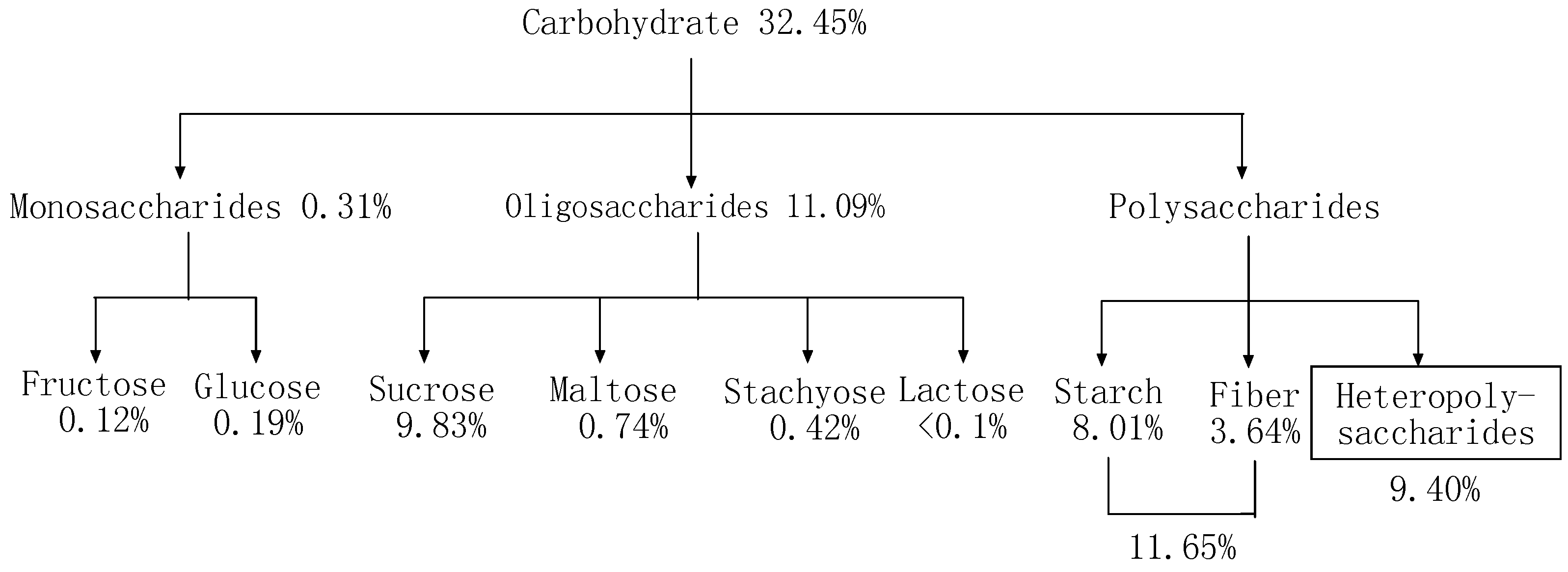

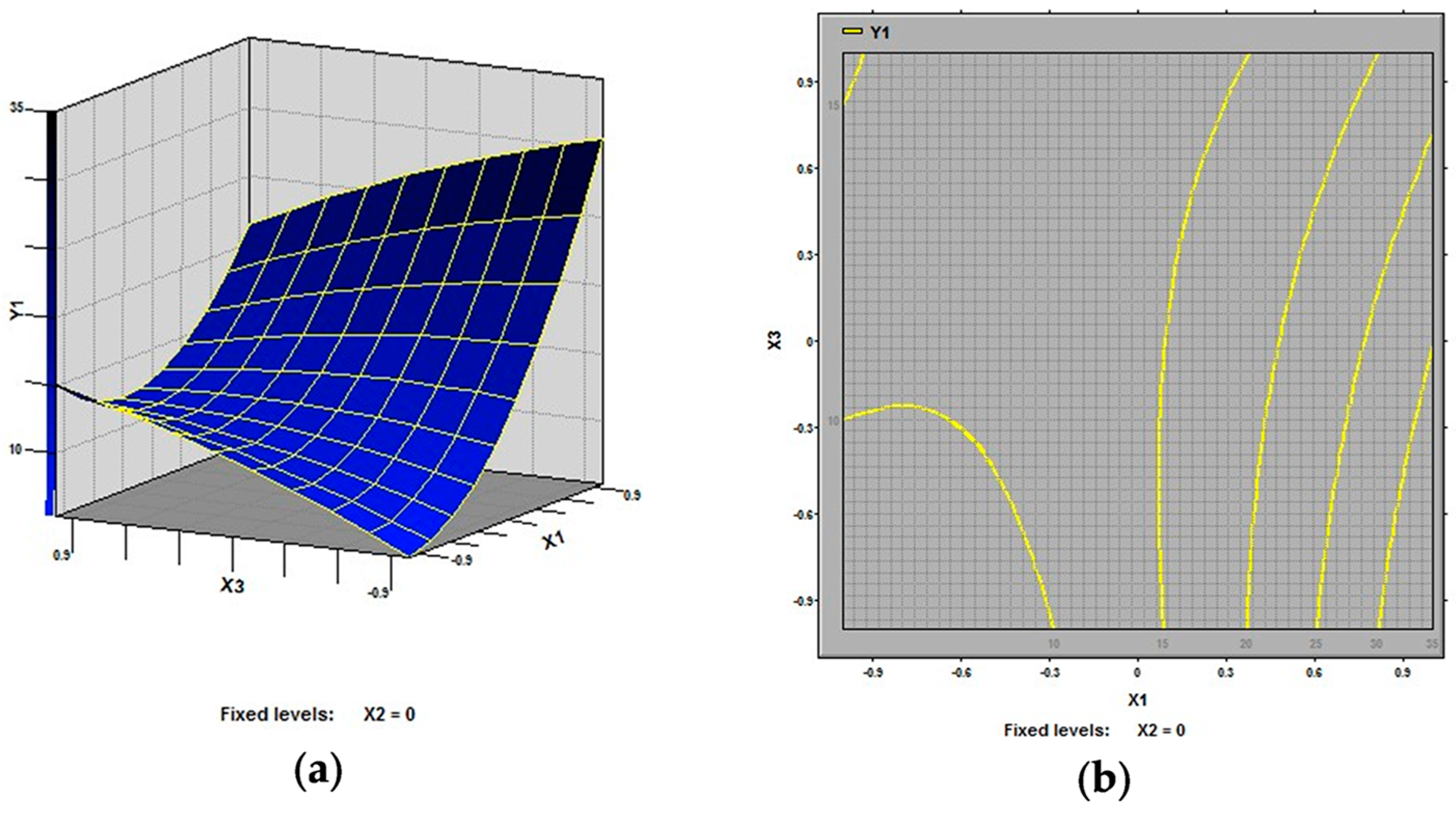

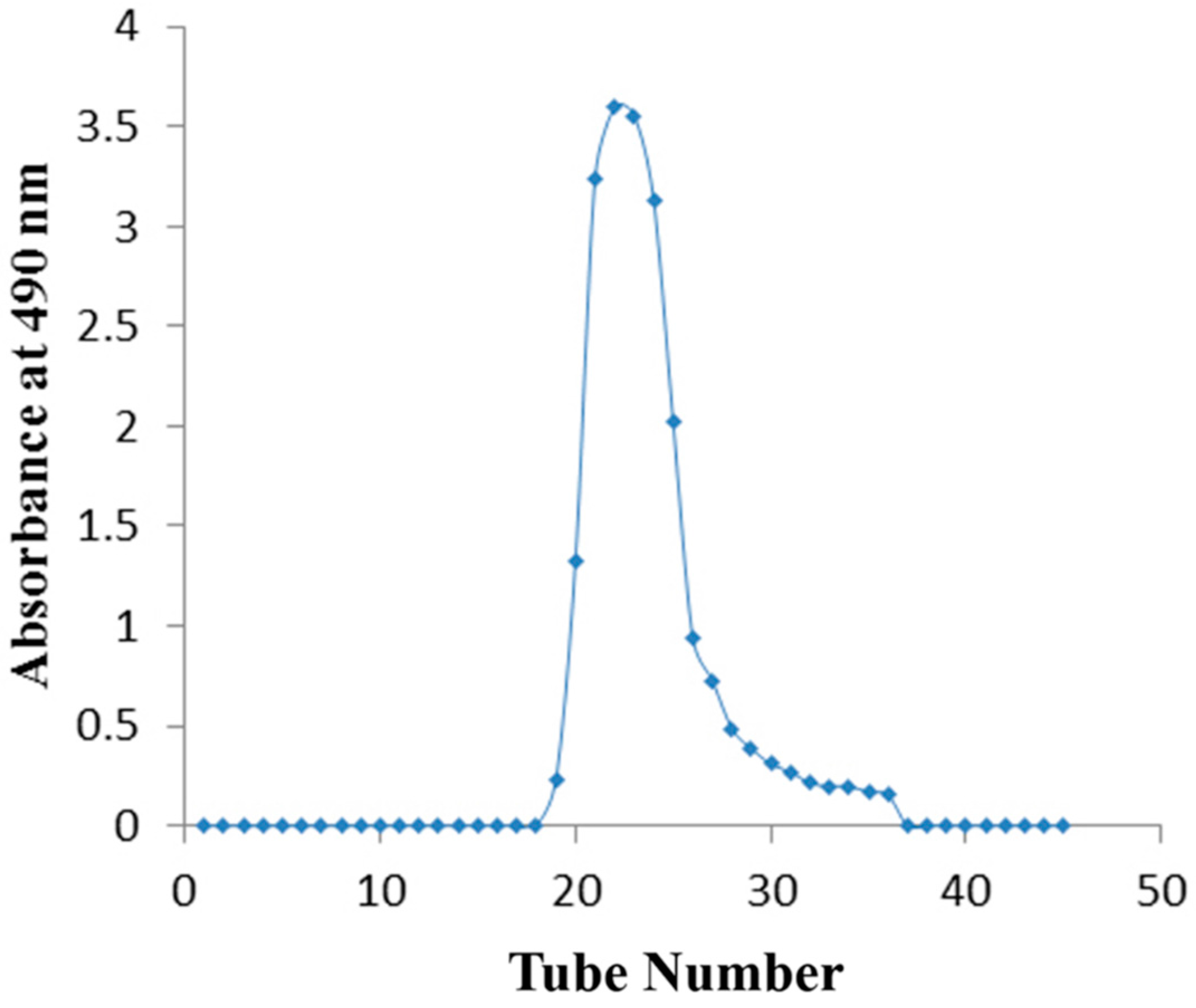
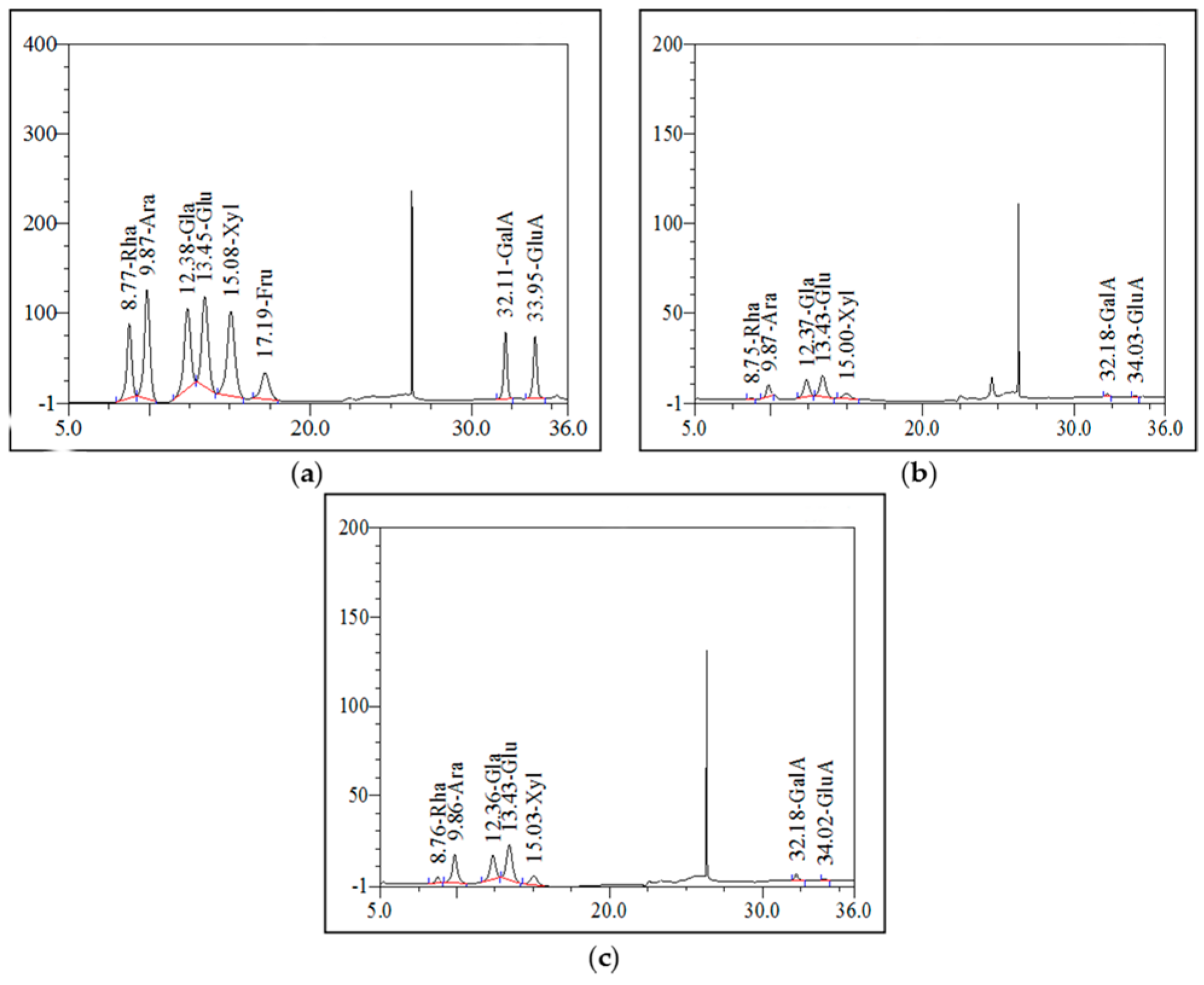
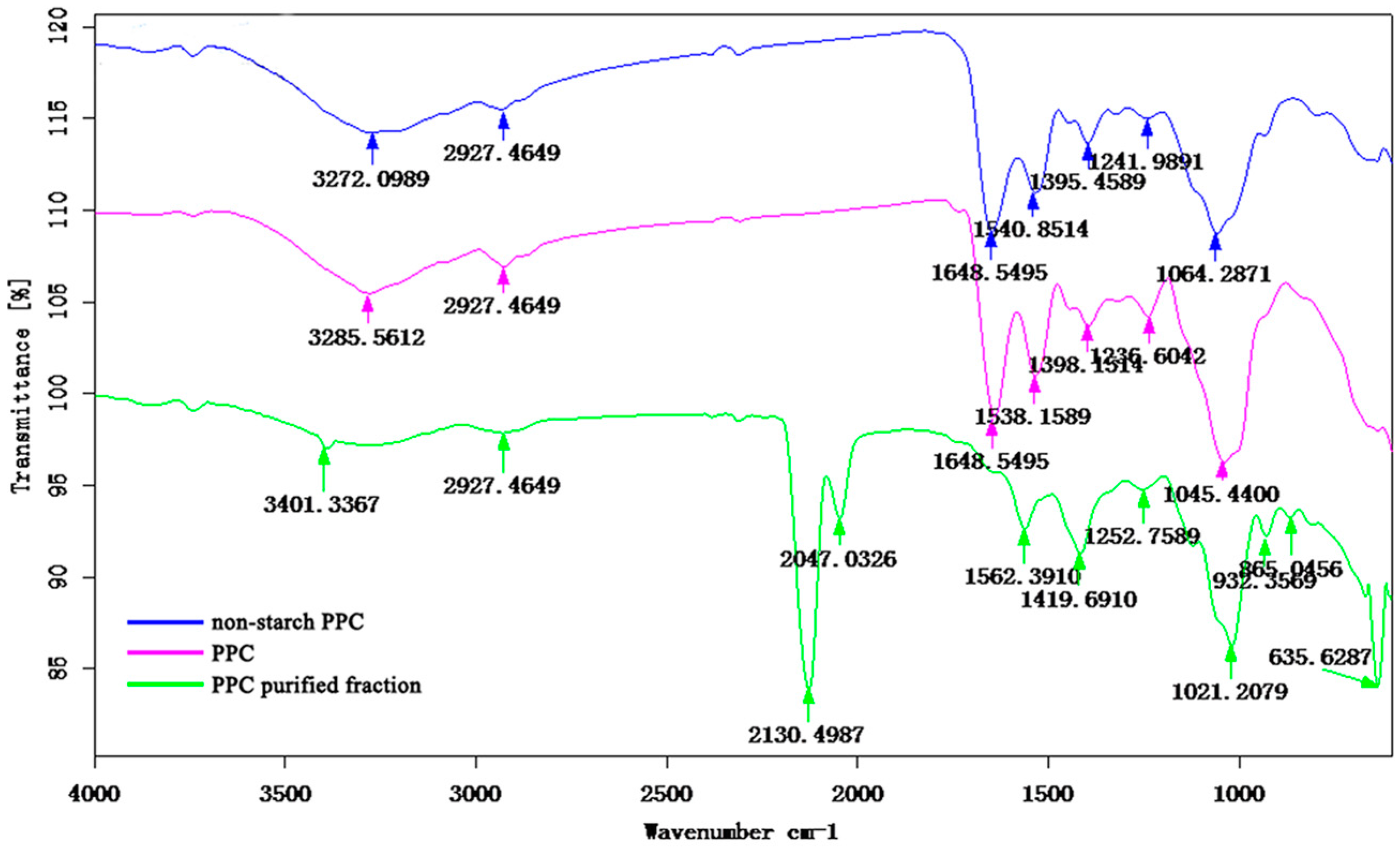
| Main Components | Moisture | Ash | Protein b | Carbohydrate | Lipid | Crude Fiber |
|---|---|---|---|---|---|---|
| Content (%) | 4.54 ± 0.04 | 8.78 ± 0.01 | 47.28 ± 0.41 | 32.45 ± 0.30 | 3.40 ± 0.06 | 3.64 ± 0.01 |
| Run Order | Coded Levels | Extraction Rate (%) | ||
|---|---|---|---|---|
| X1 | X2 | X3 | ||
| Temperature (°C) | Time (h) | Water to Material Ratio (mL/g) | ||
| 1 | −1 | −1 | 0 | 2.89 |
| 2 | −1 | 1 | 0 | 3.29 |
| 3 | 1 | −1 | 0 | 20.11 |
| 4 | 1 | 1 | 0 | 23.45 |
| 5 | 0 | −1 | −1 | 4.60 |
| 6 | 0 | −1 | 1 | 4.35 |
| 7 | 0 | 1 | −1 | 6.23 |
| 8 | 0 | 1 | 1 | 4.54 |
| 9 | −1 | 0 | −1 | 5.53 |
| 10 | 1 | 0 | −1 | 34.91 |
| 11 | −1 | 0 | 1 | 15.72 |
| 12 | 1 | 0 | 1 | 22.85 |
| 13 | 0 | 0 | 0 | 14.23 |
| 14 | 0 | 0 | 0 | 13.99 |
| 15 | 0 | 0 | 0 | 14.13 |
| Source | Degrees of Freedom | Sum of Squares | Mean Square | F Value | Pr > F |
|---|---|---|---|---|---|
| X1 | 1 | 682.44 | 682.47 | 5832.13 | 0.0001 |
| X2 | 1 | 3.86 | 3.86 | 33.02 | 0.0022 |
| X3 | 1 | 1.81 | 1.81 | 15.51 | 0.0109 |
| X1X1 | 1 | 159.40 | 159.40 | 1362.17 | 0.0001 |
| X1X2 | 1 | 2.16 | 2.16 | 18.47 | 0.0077 |
| X1X3 | 1 | 123.77 | 123.77 | 1057.66 | 0.0001 |
| X2X2 | 1 | 251.43 | 251.43 | 2148.68 | 0.0001 |
| X2X3 | 1 | 0.52 | 0.52 | 4.43 | 0.0892 |
| X3X3 | 1 | 3.23 | 3.23 | 27.56 | 0.0033 |
| Model | 9 | 1261.32 | 140.15 | 1197.65 | 0.0001 |
| Error | 5 | 0.58 | 0.12 | 12.75 | 0.0735 |
| Total | 14 | 1261.91 |
| Source | Master Model | Predictive Model |
|---|---|---|
| Mean | 12.72133 | 12.72133 |
| R2 | 99.95% | 99.95% |
| Adj. R2 | 99.87 | 99.87 |
| RMSE | 0.342079 | 0.342079 |
| CV | 2.689022 | 2.689022 |
| Conditions | Extraction Temperature (°C) | Extraction Time (h) | Ratio of Water to Raw Material (mL/g) | Extraction Rate of Polysaccharides (%) |
|---|---|---|---|---|
| Optimum conditions | 83.7 | 2.8 | 18:1 | 34.97 (predicted) |
| Modified conditions | 85 | 3 | 20:1 | 34.49 ± 0.3 (actual) |
| Sample | Total Sugar (%) | Protein (%) | Total Starch (%) |
|---|---|---|---|
| PPC | 87.67 ± 0.07 | 10.53 ± 0.22 | 60.92 ± 1.06 |
| Non-starch PPC | 44.40 ± 0.10 | 40.73 ± 0.10 | 4.19 ± 0.06 |
| Purified fractions | 82.46 ± 0.08 | nd | nd |
| Independent Variables | Symbol | Coded Factor Level | ||
|---|---|---|---|---|
| Coded | −1 | 0 | 1 | |
| Temperature (°C) | X1 | 70 | 80 | 90 |
| Extraction time (h) | X2 | 2 | 3 | 4 |
| Ratio (mL/g) | X3 | 15:1 | 20:1 | 25:1 |
© 2016 by the authors. Licensee MDPI, Basel, Switzerland. This article is an open access article distributed under the terms and conditions of the Creative Commons Attribution (CC-BY) license ( http://creativecommons.org/licenses/by/4.0/).
Share and Cite
Liu, H.; Jiang, N.; Liu, L.; Sheng, X.; Shi, A.; Hu, H.; Yang, Y.; Wang, Q. Extraction, Purification and Primary Characterization of Polysaccharides from Defatted Peanut (Arachis hypogaea) Cakes. Molecules 2016, 21, 716. https://doi.org/10.3390/molecules21060716
Liu H, Jiang N, Liu L, Sheng X, Shi A, Hu H, Yang Y, Wang Q. Extraction, Purification and Primary Characterization of Polysaccharides from Defatted Peanut (Arachis hypogaea) Cakes. Molecules. 2016; 21(6):716. https://doi.org/10.3390/molecules21060716
Chicago/Turabian StyleLiu, Hongzhi, Nan Jiang, Li Liu, Xiaojing Sheng, Aimin Shi, Hui Hu, Ying Yang, and Qiang Wang. 2016. "Extraction, Purification and Primary Characterization of Polysaccharides from Defatted Peanut (Arachis hypogaea) Cakes" Molecules 21, no. 6: 716. https://doi.org/10.3390/molecules21060716





